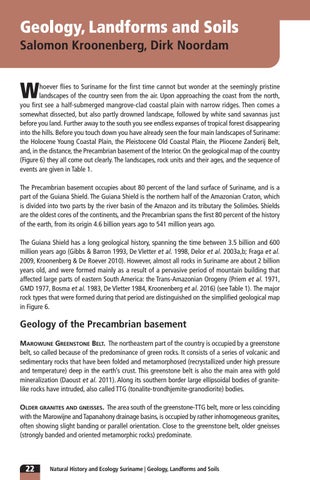02_chapter geology-22-39_final_Layout 1 22.12.17 17:31 Seite 22
Geology, Landforms and Soils Salomon Kroonenberg, Dirk Noordam
W
hoever flies to Suriname for the first time cannot but wonder at the seemingly pristine landscapes of the country seen from the air. Upon approaching the coast from the north, you first see a half-submerged mangrove-clad coastal plain with narrow ridges. Then comes a somewhat dissected, but also partly drowned landscape, followed by white sand savannas just before you land. Further away to the south you see endless expanses of tropical forest disappearing into the hills. Before you touch down you have already seen the four main landscapes of Suriname: the Holocene Young Coastal Plain, the Pleistocene Old Coastal Plain, the Pliocene Zanderij Belt, and, in the distance, the Precambrian basement of the Interior. On the geological map of the country (Figure 6) they all come out clearly. The landscapes, rock units and their ages, and the sequence of events are given in Table 1. The Precambrian basement occupies about 80 percent of the land surface of Suriname, and is a part of the Guiana Shield. The Guiana Shield is the northern half of the Amazonian Craton, which is divided into two parts by the river basin of the Amazon and its tributary the SolimĂľes. Shields are the oldest cores of the continents, and the Precambrian spans the first 80 percent of the history of the earth, from its origin 4.6 billion years ago to 541 million years ago. The Guiana Shield has a long geological history, spanning the time between 3.5 billion and 600 million years ago (Gibbs & Barron 1993, De Vletter et al. 1998, Delor et al. 2003a,b; Fraga et al. 2009, Kroonenberg & De Roever 2010). However, almost all rocks in Suriname are about 2 billion years old, and were formed mainly as a result of a pervasive period of mountain building that affected large parts of eastern South America: the Trans-Amazonian Orogeny (Priem et al. 1971, GMD 1977, Bosma et al. 1983, De Vletter 1984, Kroonenberg et al. 2016) (see Table 1). The major rock types that were formed during that period are distinguished on the simplified geological map in Figure 6.
Geology of the Precambrian basement MAROWIJNE GREENSTONE BELT. The northeastern part of the country is occupied by a greenstone belt, so called because of the predominance of green rocks. It consists of a series of volcanic and sedimentary rocks that have been folded and metamorphosed (recrystallized under high pressure and temperature) deep in the earth’s crust. This greenstone belt is also the main area with gold mineralization (Daoust et al. 2011). Along its southern border large ellipsoidal bodies of granitelike rocks have intruded, also called TTG (tonalite-trondhjemite-granodiorite) bodies. OLDER GRANITES AND GNEISSES. The area south of the greenstone-TTG belt, more or less coinciding with the Marowijne and Tapanahony drainage basins, is occupied by rather inhomogeneous granites, often showing slight banding or parallel orientation. Close to the greenstone belt, older gneisses (strongly banded and oriented metamorphic rocks) predominate.
22
Natural History and Ecology Suriname | Geology, Landforms and Soils
